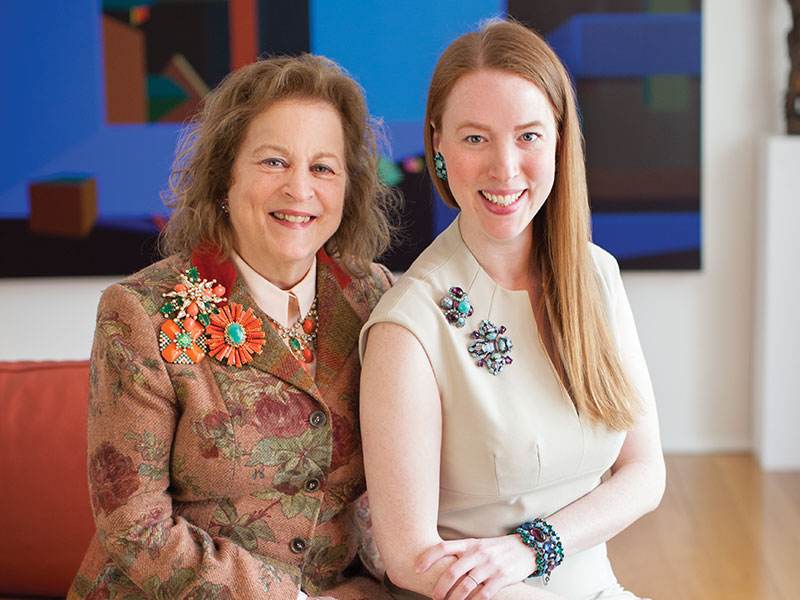More than a pictorial epic of faux bijoux, Schreiner: Masters of Twentieth-Century Costume Jewelry is notable in the historic scheme of fashion and design. Authors Carole Tanenbaum and Eve Townsend have mingled images of Tanenbaum’s cache of utterly dazzling costume jewelry – all created by the now-defunct Schreiner Jewelry Company – with interesting vignettes that give perspective to the evolutionary epochs of feminist style, from the popular rise of couture fashions that flaunted gems as signs of social status to the democratization of style that cultivated affordable ideals for any woman craving a sparkly adornment.
A veritable maven in the international realm of vintage costume jewelry, Tanenbaum started collecting it in the 1970s. While prowling an antique show in London, England, with her husband, Howard, who collected early photography, she was smitten by a case of 20 unique pieces – “each an object of art” – and the idea of “wearing a part of history” with “the wow fashion statement that no genuine gem jewelry could give.” When her collection grew to 3,500 items, she approached the Holt Renfrew store in Toronto, which ultimately branded an exclusive department as the Carole Tanenbaum vintage collection. Her favourite pieces were illustrated in her first book, Fabulous Fakes: A Passion for Vintage Costume Jewelry. 
Today, Tanenbaum’s treasure trove includes 30,000 pieces dating from the Victorian era to contemporary collectibles. Her name is mentioned in the crème de la crème of international fashion and lifestyle magazines. She is often sought as the accessory source by designers for film and television shows, including the series Suits, not to mention personally by the likes of Michelle Obama and Sarah Jessica Parker.
Tanenbaum’s most requested pieces were originally crafted by Schreiner Jewelry Company. Started in 1932, it ceased manufacturing in 1975, leaving virtually no documented history, as well as a mystery about why some pieces are signed Schreiner, yet others featuring the company’s distinctive, unique construction techniques are unsigned.
When Tanenbaum’s passion for Schreiner pieces was recognized by Eve Townsend, who was working for her while writing a thesis at Ryerson University on the history of costume jewelry, she was determined to discover the story. Tanenbaum sent Townsend to New York. After researching archives, Townsend followed a whim and found descendants of company founder Henry Schreiner living in Poughkeepsie, N.Y. This book is the culmination of interviews with his daughter Terry Schreiner Albert, now about 85, and her collected images.
Henry Schreiner grew up in Bavaria, Germany, and immigrated to New York in 1923. While working for a shoe buckle company, he learned to solder and set stones. Later, on his own, he started making buttons, belt buckles and jewelry. The book details Schreiner’s travels to Paris for fashion inspiration and how, in 1939, he amassed a cache of stones in a Czechoslovakian hold. The story veers to romance involving daughter Terry and a dashing young German, Ambrose Albert, who had been studying mechanical engineering before being drafted into the German army. Albert immigrated to New York and married Terry, who was working with her father. When Henry became ill, Albert pitched in and soon turned his engineering talent to creating jewelry. Contrary to previous conceptions, it was actually Albert who designed 90 per cent of the most spectacular pieces, likely after 1950.
Originally, Schreiner designs were commissioned and sold exclusively to high-end coat and clothing designers, including Dior, Adele Simpson, Norman Norell and Pauline Trigère, who insisted their signature embellishments be unsigned by Schreiner. Notoriously, a certain ilk of ladies would try on garments just to steal a pin. When post-Second World War optimism was flying high, department stores wanted to sell affordable, signed Schreiner designs, making them democratically accessible beyond the couture crowd. Among these stores were Harrod’s in London, and Simpson’s, Morgan’s and Holt Renfrew in Canada.
READ: ACTIVIST TEEN ADDS AUTHOR TO RESUME
Using stones from Czechoslovakia, Germany and occasionally Austria, Albert created a unique design for each cluster of uncut stones. Notably, in his oeuvre of hundreds of designs, he rarely created multiples, as other designers did, although he did create small series. Albert posed audacious colour combinations, like grouping lime green with lapis blue, or turquoise with purple. He often set stones in an inverted or upside-down style, with the point up, to maximize depth and sparkle. He designed a hook-and-eye construction to give brooches raised dimension, and often added a pendant hook for use as a necklace.
Signature designs included brooches with fancy prongs on crimped cup settings, designs featuring clusters of tiny crystals, bracelets and necklaces crafted on parallel chains, lavish necklaces and stretch metal belts adorned with jewelled buckles. Famed model Suzy Parker was renowned for wearing a diamenté necklace, and actress Marilyn Monroe for a shimmering pearl bib necklace. Tanenbaum calls the iconic ruffle pin the “Mona Lisa of Schreiner’s oeuvre.”
After Terry identified many of her unsigned pieces as authentic Schreiner, Tanenbaum gained the confidence to detail the identifying signature Schreiner characteristics. Destined to be a valuable research source, this book will undoubtedly lure many costume jewelry collectors riffling through their own cache of baubles for Schreiner authenticity, myself included.







